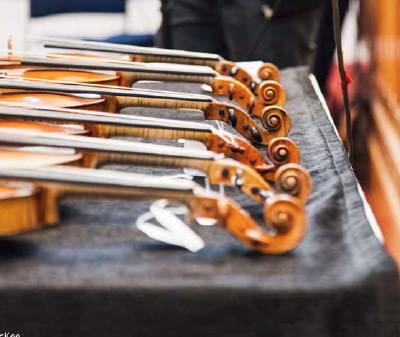Notable Sales: Giuseppe Antonio Rocca
Giuseppe Rocca learned his craft in Turin from Giovanni Francesco Pressenda, to whom he was apprenticed from 1834 to 1838. Rocca was making instruments independently by 1838, and by the mid-1840s he had departed almost entirely from Pressenda’s patterns, modelling his instruments after Stradivari and Guarneri del Gesù.
The 1840s and 1850s are considered the pinnacle of Rocca’s career, and these years produced some superlative violins, both aesthetically and tonally. At some point he must have made the acquaintance of the collector Luigi Tarisio, who had acquired much of Count Cozio’s collection in 1827. It was through Tarisio that Rocca became acquainted with the ‘Messie’ Stradivari of 1716 and the ‘Alard’ Guarneri del Gesù of 1742, and he made numerous copies of both instruments. The 1852 ‘Messie’ copy is unusual in that it has a deep red varnish, no doubt an attempt to recreate some of the quality of the original. The 1850 violin is more typical of Rocca’s Stradivari copies and was undoubtedly given its antiqued look by the maker. Some of his instruments are made from a worm-infested plank said to have been taken from a bridge in Turin (see the back of the 1846 ‘Alard’ copy).
From 1851, Rocca commuted between Turin and Genoa, finally settling in Genoa in 1863. He seems to have had an extremely turbulent domestic life, apparently due to a love of drink, gambling and women. He was married five times and it has been suggested that his last wife, aged 18, may have driven him to his death by drowning in 1865.
(b Barbaresco, nr. Alba, 1807; d Genoa, 1865)
Giuseppe Rocca learned his craft in Turin from Giovanni Francesco Pressenda, to whom he was apprenticed from 1834 to 1838. Rocca was making instruments independently by 1838, and by the mid-1840s he had departed almost entirely from Pressenda’s patterns, modelling his instruments after Stradivari and Guarneri del Gesù.
The 1840s and 1850s are considered the pinnacle of Rocca’s career, and these years produced some superlative violins, both aesthetically and tonally. At some point he must have made the acquaintance of the collector Luigi Tarisio, who had acquired much of Count Cozio’s collection in 1827. It was through Tarisio that Rocca... Read more
26 April 2021 - Dilworth, John
The Evolution of Violin Making from 16th-20th Century Part VI
05 June 2018 - Dilworth, John
Giuseppe Rocca was born in 1807 in Barbaresco, a town in Piedmont now famous for its wine. He did not remain there long however. By about 1822 he was working in Turin, where he came under the influence of Giovanni... Read more
We offer buyers and sellers a bespoke private sale service, sourcing exceptional instruments and bows and matching them with the most discerning buyers.
More InformationTim Ingles and Paul Hayday will offer an initial evaluation of the authenticity and value of your instrument or bow to recommend an auction estimate and reserve price.
Enquire
Tim Ingles and Paul Hayday will offer an initial evaluation of the authenticity and value of your instrument or bow. At this stage, the assessment is free and without obligation. In the first instance, we suggest submitting good-quality images to us, preferably by email to info@ingleshayday.com or by completing the valuation form.
Read more